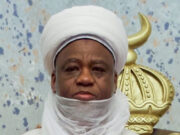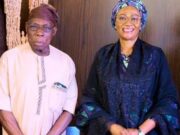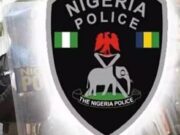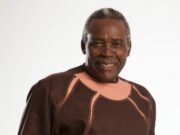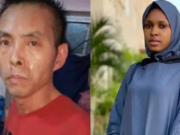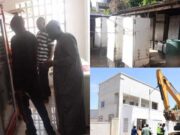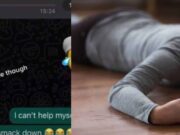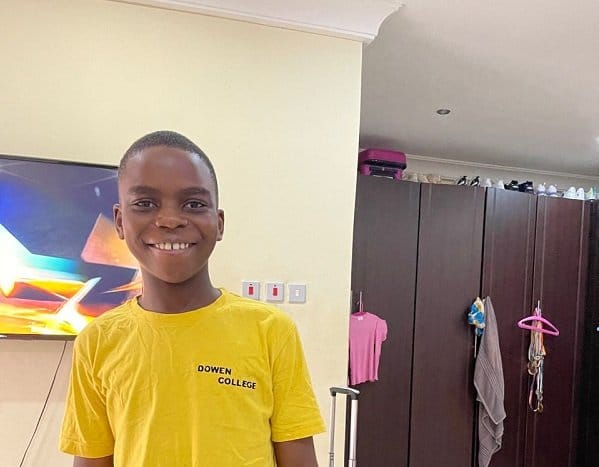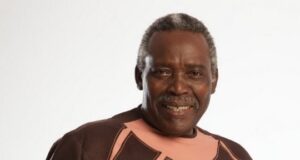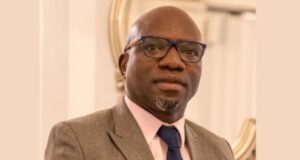
Sometime in December 2021, a disturbing video of a pre-teen boy writhing in pain was posted online. In the footage, the boy, a pupil of Dowen College, a boarding secondary school in the highbrow Lekki Phase 1 estate in Lagos, seemed to be fighting for his life. A few days later, the boy, named Sylvester Oromoni, same as his father, died a few days to his 12th birthday.
Mr Oromoni, Sylvester’s father, accused five pupils of the school – Aslem Temile (14), Benjamin Favour (16), Michael Kashamu (15), Edward Begue (16) and Kenneth Inyang – of killing his son. He claimed that the pupils bullied his son to death after he refused to join a secret cult. He claimed his son named these pupils moments before he passed.
Earlier, Sylvester’s cousin, Perry Oromoni, in a series of tweets, suggested Dowen college was a haven for teenage cult members recruiting other pupils into their gang.
Subsequently, the school came under a barrage of criticism by many Nigerians who felt it was not being upfront with details of the tragic event. Some people, who sympathised with Sylvester’s parents, felt the school management did not do enough to curb bullying among its pupils.
For instance, more than 200,000 people signed a petition seeking justice in the case. The outrage generated by the death of Sylvester, who was fondly called “Junior” (because he was named after his father), forced the state government to temporarily shut down the school while it investigated the incident.
However, the management of Dowen College, in a statement, claimed an employee of the school informed it on November 21 that Sylvester was injured during a football match with fellow pupils and was not a victim of bullying. The school added that he was immediately treated by its in-house nurse and seemed to be fine initially. But the next day he complained of pain. It also dismissed the claim that Sylvester was killed after he refused to join a cult.

“Preliminary investigation showed that there was no fighting, bullying, or any form of attack on the boy,” the statement read in parts.
“He made no such reports, neither to his sister who is also a student, nor any other students, prefects, house parents, medical staff, or any of the management staff. The school has two regular nurses and a qualified medical doctor that promptly attends to students. [We] will not tolerate any acts of cultism which is why there is nothing like that,” the statement added.
The Lagos State Director of Public Prosecutions, Adetutu Oshinusi, also said the allegations against the accused students and their schools could not be sustained in a court of law.
Contents
DOWNLOAD LEGAL ADVICE BY LAGOS STATE’S DIRECTOR OF PUBLIC PROSECUTION HERE
Was Sylvester killed for refusing to join the cult as his father claimed? Was he a victim of bullying? Was the school being honest about its claim that Sylvester suffered the injury that might have led to his death during a football game? What was the role of Mr Oromoni who is still insisting that his son was killed by the alleged bullies and teenage cultists at Dowen College?
For several weeks, PREMIUM TIMES carefully reviewed all the information – including results of two autopsies carried out on Sylvester – around the event with the aim of unearthing the facts of the case. We also spoke to Mr Oromoni, lawyers, and representatives of the accused pupils, pathologists, and several individuals knowledgeable about the matter. What we found was a case of negligence, the reliance on miracle healing and religious authority over medical treatment, and medical errors bordering on unprofessionalism by a doctor who treated Sylvester before he died and another who conducted an autopsy on his body soon after his death.
No evidence of physical injuries
In several interviews, Mr Oromoni claimed his son was beaten by the quintet of “teenage bullies of Dowen College”, and that was what led to his sudden death. He alleged that the boys barged into his son’s room at night, switched off the hostel lights and beat him up. He said his son told him this, moments before he died.
“Junior said, ‘mummy, I didn’t play ball; I didn’t fall’,” Mr Oromoni told The Cable newspaper “He jumped off his hostel bed. They kicked him, matched his waist. Other students ran off. They threatened to kill them all if they spoke a word to the school staff. They warned Junior to say he sustained injuries while playing ball. They threatened him. If you ask the roommate, they’d all lie. They matched his ribs and waist. All that pain for a 12-year-old.”

Mr Oromoni later told PREMIUM TIMES, that his son told him moments before he died about how the alleged bullies whipped him multiple times with their belts. He claimed that the severe torture meted on his son was the cause of the injuries that led to his death.
On Monday, November 21, 2021, Rosemary Oromoni, Sylvester’s mother, received a call from a nurse at the sickbay of the college. She was informed that her son could not sleep through the night. When Peter Odeworitse, a family friend of Mr Oromomi, picked the boy from the school the next day, his health had deteriorated considerably – his body was aching and his legs were itching. He was making physical gestures that showed he had severe body pains.
His parents, who were in Warri Delta State at the time, then instructed Mr Odeworitse to take the boy for an x-ray to understand the possible cause of the pain.
Mr Oromoni admitted to this newspaper that the result of the x-ray contradicted his claim that his son was physically assaulted.
“The x-ray showed nothing. No dislocation and no fracture,” Mr Oromoni told PREMIUM TIMES. “The doctor who did the x-ray now advised that we should use hot balms to rub his body.”
Medical experts who spoke to PREMIUM TIMES said the description of how Sylvester was allegedly beaten does not match the outcome of the x-ray. Their verdicts were that there should be either internal or external injuries if his father’s description of what led to his death was to be believed.
“What the father said showed the boy must have been beaten severely. So, there should be one or two signs to show for it,” said Victor Biryi, an epidemiologist with a background in radiology. “If he was beaten that much, the x-ray would show at least one or two internal or external scars.”
Left to die at home
When Mr Oromoni learned his son was ill and in pain, he flew down to Lagos and travelled back to Warri by road for several hours with the ailing boy because there was no flight to Warri at the time. A few hours after arriving in Warri on November 26, Junior’s health had worsened.
In a video clip filmed by his relatives, he was seen twitching in pain. His legs and stomach appear bloated. His lips and teeth seemed reddened as if stained with blood. His mother was seen murmuring in tears and condemning those who had “hit my boy like this”.
PREMIUM TIMES understands from sources close to the family, who asked not to be named because they were not permitted to speak to the media on the matter, that Mr Oromoni did not immediately take Sylvester to a hospital for a professional examination.
Mr Oromoni, however, claimed he took his boy to Vicah Clinic, his family hospital in Warri, for treatment but there was no bed space, which necessitated taking him back home.
Asked why he didn’t take the boy to another hospital, he replied: “Can’t I ask a doctor to come and treat my son at home? Is it not the same thing? The hospital is not far from my house so I asked that he should be treated at home.”
Aghogho Owhojede, the family doctor to Mr Oromoni, declined PREMIUM TIMES calls when contacted several times to confirm if his hospital indeed had no bed space to accommodate the sick boy.
“I am not going to answer any question on this issue,” he told this reporter on one occasion.
Meanwhile, Mr Oromoni had told us that between the 26th and 30th of December, 2021, his son was given malaria pills as recommended by the doctor.
The family doctor would later appear before a Lagos coroner to give testimonies that experts said showed the sick boy died a terrible death due to lack of proper medical attention.
A clinical note without a diagnosis
On February 2, Anthony Kpokpo, Dowen College’s lawyer, unsettled Mr Owhojede as he appeared before Mikail Kadiri, the coroner at the Ikeja court. The doctor claimed he treated Sylvester for five days before he finally died on November 30. But his claims contradicted that of Mr Oromoni on how his son was treated before he died.
PREMIUM TIMES observed that the family doctor was evasive during the cross-examination, especially when questioned about his “unethical methods” of handling the ailing child.
On November 26, the doctor said, he noticed that the deceased’s liver was enlarged but he felt that called for no concern. He would later present a clinical note without a diagnosis as evidence. When asked if he didn’t think that was directionless, he said “no”, stating that it’s normal to treat a patient without a diagnosis.
Mr Owhojede told the coroner that he had no access to the boy for over 32 hours even though it was clear he was battling with “severe painful distress with an enlarged liver”.

In an earlier statement to the police in Warri, the doctor had claimed that the deceased was brought dead to his hospital. But while testifying before the coroner, he insisted that the boy died in his hospital. Yet, he failed to issue a death certificate, citing “sadness and wailing” as his reasons. He said the wailing affected his professional judgement because he saw the boy in pain for five days.
Hameed Adediran, a medical consultant, told PREMIUM TIMES that although medical emergencies can only be determined by the physician, there must be assurances that symptoms shown by a patient such as the case of Sylvester are not life-threatening.
“An enlarged liver is caused by something,” he said. “The doctor then must find out what is causing the enlarged liver. What caused the enlarged liver may not be an emergency in the case of poisoning, for example. So, the question is always about what is causing the enlarged liver.”
The medical consultant also stated that clinical notes can be issued without diagnosis only on very rare occasions. He said that can be possible if the physician does not have access to an investigation or even the history of what could have caused the patient’s ailment. He however condemned the excuse given by the doctor for not issuing a death certificate after claiming that the ailing boy died in his hospital.
Waiting for miracle antidotes from the ‘Bishop of the World’
Mr Oromoni is a member of the God’s Grace Ministry, a Pentecostal church in Delta State. Instead of taking his son to a hospital after he arrived in Warri, he took him to his church where he hoped the boy would be healed by the founder of the church, Dikeji Daniel, alias Miyerijesu, a PREMIUM TIMES investigation revealed.
Although Mr Oromoni denied taking his son to the church for healing, sources close to him insisted that priority was indeed placed on Mr Daniel, a bishop, to heal the ailing boy. The sources also added that he waited for his pastor’s blessings before taking his son to hospital.
“What kind of statement is that?” Mr Oromoni told PREMIUM TIMES when asked why he chose to take his son to church for healing instead of taking him to hospital. “Even my pastor goes to the hospital. My family doctor is also a member of the church,” he said.
But Mr Owhojede admitted to the coroner that Mr Oromoni indeed took the boy to church presumably to heal him of his ailment miraculously. He also told the coroner that he could not treat the boy for more than 32 hours. However, he did not state why he was unable to attend to his critically ill patient for that long stretch of time.
However, Mr Owhojede, who had been the family doctor to Mr Oromoni for over 15 years, said there was nothing wrong with taking the ailing boy for prayers after admitting that the church is not a treatment centre.
“I am aware that the church is not a treatment centre. I am not against prayer, I will prefer a combination of both prayer and medical treatment,” the doctor said during cross-examination at the Ikeja Corona Court.
“Can you confirm that the deceased was not taken to any hospital for treatment?” Mr Owhojede was asked.
“No, he wasn’t, my lord,” he replied.
Mr Oromoni might have been swayed by the public testimonies of several members of the church who claimed to have received divine healings from Mr Daniel.
For example, in 2019, Joy Ola, a member of the church claimed she was risen from the dead by the “Bishop of the whole world”, as members of the church call Mr Daniel.
“For a year, I suffered from general body weakness,” he narrated to other church members. “And also, there was a big sore in my private part. All medical doctors, including witch doctors I visited, tried their best but all to no avail.
“On the 4th of February, 2017 my condition became worse to the extent of giving up the ghost. Luckily for me, on that very day, the Bishop of the whole world was holding a 4-day miracle crusade at Uromi town. So I was rushed to the crusade arena, dead on a stretcher.
“According to the people who helped me that day, the Bishop of the whole world was about to pray the prayer of deliverance for the new converts, when some of the ushers quickly carried me to the platform where the Bishop of the whole world laid his hand on me. Immediately after the prayer of the Bishop of the whole world, I came back to life. I, who was taken to the crusade arena dead on a stretcher, rose and began to walk. Hallelujah!”, she said.
The anointed chewing gum at God’s Grace Ministry
At the God’s Grace Ministry, ailing members jostle to get the blessing of Mr Daniel before proceeding to hospitals, PREMIUM TIMES was told.
It is a long time practice in the church led by a bishop who claimed to have been anointed by Jesus Christ to save the world from the shackles of the devil.
PREMIUM TIMES gathered that while some church members may have testified to have benefited from the miracle healings of the pastor, many others have been exposed to dangers or death as they scrambled to receive his divine healing.

A former member of the church, who asked not to be identified for fear of being victimised, told this reporter how several sick members were given “anointed chewing gums” while they waited to get the pastor’s blessings before proceeding to hospitals for treatment. The anointed chewing gum, another source said, is “the first aid given to sick church members before the arrival of the Bishop of the World”.
“There was this church member who was very sick and now is late. Instead of her going to the hospital, the woman went to church to inform the pastor that she was sick. The church is big. And because the church is very big, she could not just go and see the pastor like that. She was given anointed chewing gum before the pastor would come. She had to be rushed to the hospital one day and she died.”
Sources familiar with the activities of the ministry also confirmed that members of the church believe so much in the miraculous power of Miyerijesu to heal their ailing relatives. The Bishop had pulled out of the Warri Anglican dioceses as one of the priests to start his ministry, which now has up to 20, 000 members in Warri alone.
Afoke (she asked to be identified only by her last name to stave off controversy), a resident of Warri, told this newspaper that after watching the video of Sylvester writhing in pain, she blamed Mr Oromoni for carelessly handling his son’s ailment.
“Immediately I saw the story, I knew that something was off,” she said. “The video that came out, and you see the way they were handling the boy. Why would he administer treatment? Is he a doctor? Is he a nurse? Why didn’t they carry the child to the hospital? If they had carried the child to the hospital, I’m sure that child would still be alive.”
‘He’s the Jesus Christ on earth’ — God’s Grace Ministry’s spokesman
A spokesperson of the church, who refused to mention his name, declined to comment on whether sick people are admitted to the church for miracle healing.
“I don’t have anything to say about it,” he told PREMIUM TIMES, when reached on a telephone number retrieved from the church’s website.
“There’s nothing like that. Anybody that utters that word has already condemned himself. That person that lied against the Bishop of the world has condemned himself,” he added.
When this reporter gave instances of ailing members who waited to receive the pastor’s blessings before going to the hospital, the spokesman declined to comment further, insisting that everything said about the ministry were untrue.
“I don’t have anything to say. You’re a journalist, I don’t have anything to say,” he said. “So, like I said, all the things they said about the church are typical lies. I repeat: ‘Anybody that says anything against the genuine man of God, the Jesus Christ on earth, has condemned himself’. Yes, he’s the Jesus Christ on earth and the Bishop of the whole world. If you don’t believe it, you’ll see it on the last day.”
The misleading autopsy on Sylvester Oromoni that sparked outrage
One of Mr Oromoni’s many claims that sparked public outrage about his son’s death was that he was forcefully given a dangerous chemical substance to drink by the alleged teenage cultists at Dowen College.
This claim was emboldened by an autopsy that circulated online a few days after Sylvester’s death. The autopsy, conducted by one Clement Vhriterhire of the Central Hospital, Warri, Delta State, pronounced the cause of death of the deceased as “acute lung injury due to chemical intoxication in a background of blunt force trauma”.
DOWNLOAD CONTROVERSIAL REPORT BY PATHOLOGIST CLEMENT VHRITERHIRE HERE
Some angry members of the public gathered in front of the school to protest. The protesters asked that the school must remain closed until justice was done.
But then, contrary to the public understanding of the matter, the autopsy also included a toxicology examination, which was not included in the original autopsy report released by Mr Vhriterhire. On December 24, the toxicology result showed that the deceased had died of septicaemia or sepsis as the disease is commonly known, as against his earlier claim.

According to Healthline Media, an American website and provider of health information headquartered in San Francisco, sepsis is a life-threatening health condition caused by a patient’s body’s response to an infection. Sepsis occurs when the immune system stops responding by releasing proteins and other chemicals to fight invading infections which trigger intensive inflammation.
“Most infections that cause sepsis are bacterial. “Sepsis causes fever, a rapid heart rate, and difficult breathing, among other symptoms. It’s a serious condition that requires swift medical treatment,” Healthline Media stated.
Medical experts and practitioners told PREMIUM TIMES that symptoms of sepsis include fever, difficulty in breathing, sweaty body, extreme pains and disorientation — an altered mental state that causes hallucinations or seeing and hearing non-existing things.
Mr Adediran said Mr Vhriterhire’s autopsy result was misleading, considering the controversies surrounding the death of the Dowen College pupil. He also said that the pathologist could have been misled by the history provided by the family of the deceased and condemned his use of “chemical intoxication in a background of force trauma” in the post-mortem result.
“Some of the things that pathologists rely on are histories,” he told PREMIUM TIMES. “If the person who provided history suggested chemical intoxication, the pathologist may be tempted to face that direction. However, it would have been safer to use a much generic term such as ‘poisoning’ rather than going specific to say chemical intoxication.
“Again, chemical intoxication can lead to liver enlargement and most of the features that he saw but putting it that way considering the controversies surrounding the case makes it look like he’s already throwing his weight behind chemical intoxication. And honestly, there are a million and one things that could be responsible for chemical intoxication.”
The medical practitioner also condemned the circulation of the autopsy result while awaiting the toxicology report. He suggested that celebrating the autopsy which was still subject to the toxicology report aggravated the misconception surrounding the case.
“Toxicology and autopsy are not entirely the same,” he said. “The pathologist could be done with the autopsy while still awaiting the toxicology report. As I said, the findings in an autopsy will be corroborated by a lot of things including history. If an enlarged liver is found, for example, the toxicology can give further insight into what exactly led to the enlarged liver. I must also say that an autopsy report should not be celebrated on account of concluding the autopsy while awaiting the toxicology report.”
Mr Vhriterhire declined to comment when contacted by this newspaper. He declined several calls placed to his verified telephone number. When he finally answered the call, he told our correspondent that he was calling a wrong number, a claim found to be untrue.
Oromoni, Dr Vhriterhire and severe sepsis
On December 14, 2021, ten (10) pathologists from different parts of Nigeria, including Mr Vhriterhire, who came from Warri to represent the Oromoni family, conducted another autopsy to know the real cause of the death of the deceased. The pathologists were led by Sunday Soyemi, a consultant pathologist.
Before the commencement of the second post-mortem examination on the body of the deceased at the Lagos State University Teaching Hospital (LASUTH) morgue, a body radiograph was done to “find out if there was any skeletal injury”. The result of the radiological investigation, obtained by PREMIUM TIMES, revealed that there was no fracture on the total body radiographs of the boy.
The outcome of the second post-mortem examination conflicted with the initial autopsy result provided by Mr Vhriterhire. The findings in the second autopsy report seen by PREMIUM TIMES include “marked pallor of organs, pneumonia (infections of the lungs), infections of the liver and kidneys as well as the heart. These infections emanated from the ankle infection”.
“Death was caused by Septicaemia following infections of the lungs and kidneys arising from the ankle wound,” the autopsy result read in parts. “No evidence of blunt force trauma in this body. The findings in the oesophagus and stomach are not compatible with chemical intoxication. Death, in this case, is natural.
“The basic factors leading to the death of the Dowen College pupil, as stipulated in the second autopsy, are Septicaemia, Lobar Pneumonia with Acute Pyelonephritis, Pyomyositis of the right ankle and Acute Bacterial Pneumonia due to severe Sepsis”.
DOWNLOAD PATHOLOGY REPORT DONE AT LAGOS STATE UNIVERSITY TEACHING HOSPITAL HERE.
The infected ankle wound found during autopsy
Mr Oromoni, however, said he suspected foul play with the manner the second autopsy was conducted. He alleged that Mr Vhriterhire, who represented his family, was sidelined. He also refuted the claim made in the autopsy report that the boy had infections “arising from the ankle wound”.
“No injury at any time. They lied,” he said when asked if his late son had an ankle injury before he died.
But Jerry Adeyemi, senior staff at Dowen College, who has been acting as the spokesperson for the school since the tragic incident, insisted that the boy “had complained of pain on his ankle after playing football on a weekend”.
He said the injury was not serious at the time and that he could walk unaided. He explained that the school could have taken the boy to its affiliate health facility, Lifeline Children Hospital, which is about a three-minute drive from the school if it was an emergency.
“The condition in the video circulated all started in Warri not when he was in Lagos, he claimed.
Oromoni: A victim of negligence?
A Lagos-based medical practitioner with vast knowledge of radiology and pathology suggested that late Sylvester could have suffered severe disorientation and hallucination when he made his dying declaration. The medical expert, who declined to be named because he’s not permitted to speak to journalists due to the sensitivity of the case, also said the boy could have been given dangerous concoctions when he was taken to the church for a miracle healing. He also said both the school and the parents failed to give the deceased the medical attention he deserved.
“The black substance found in the boy’s stomach could even be as a result of the ‘trado-medical” medicines prepared for him in church,” he said. “The parents have a larger share of the blame for the death of their son.”
Corroborating the above analysis, Dr Adediran said the pathologist that revealed that the boy died of sepsis is more painstaking in his submission. He also said the parents could have saved the life of their child if they didn’t treat the case mildly which led to his death.
Dr Soyemi, who has conducted over 500 autopsies as a pathologist, blamed the parents of the deceased for negligence, saying sepsis, which led to the death of the boy, could have been treated with “massive doses of intravenous antibiotic, intravenous fluid and blood transfusion”.
The pathologist insisted that the first pathologist who conducted the initial autopsy on the deceased failed to cut som



